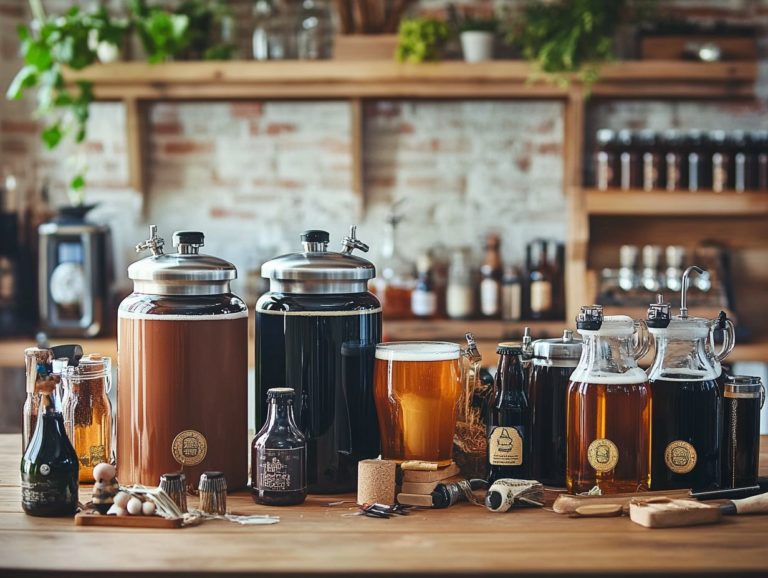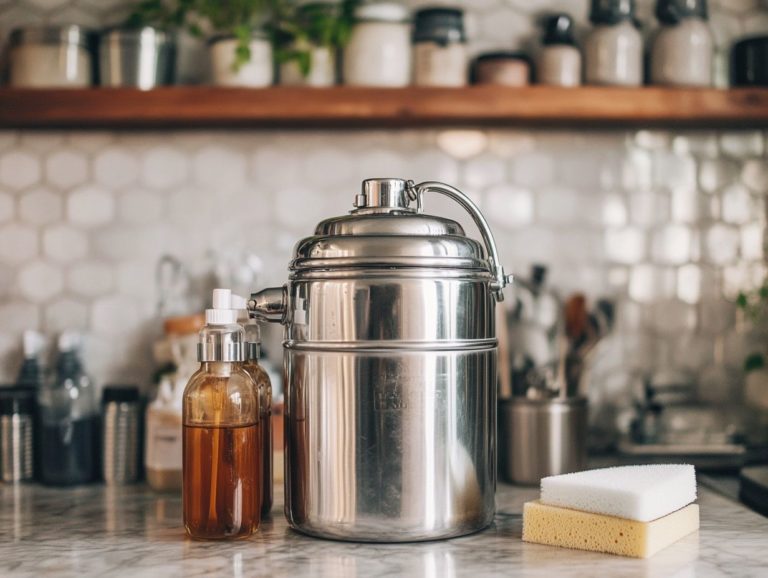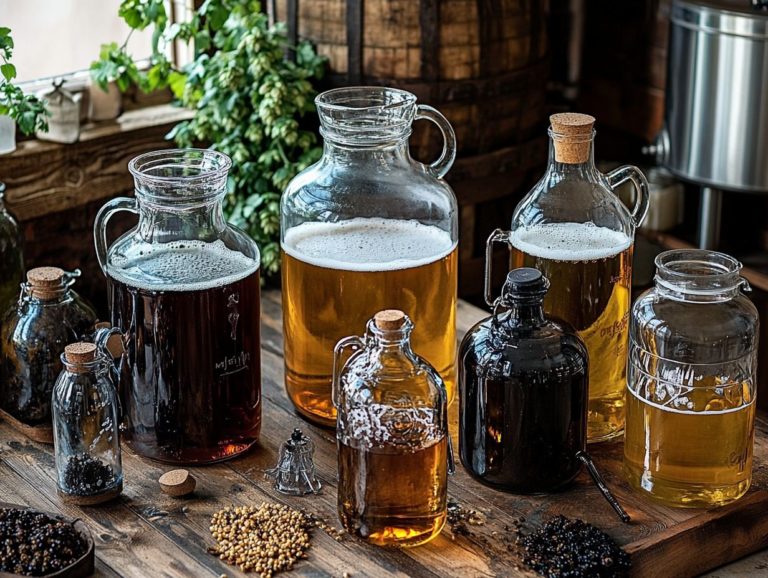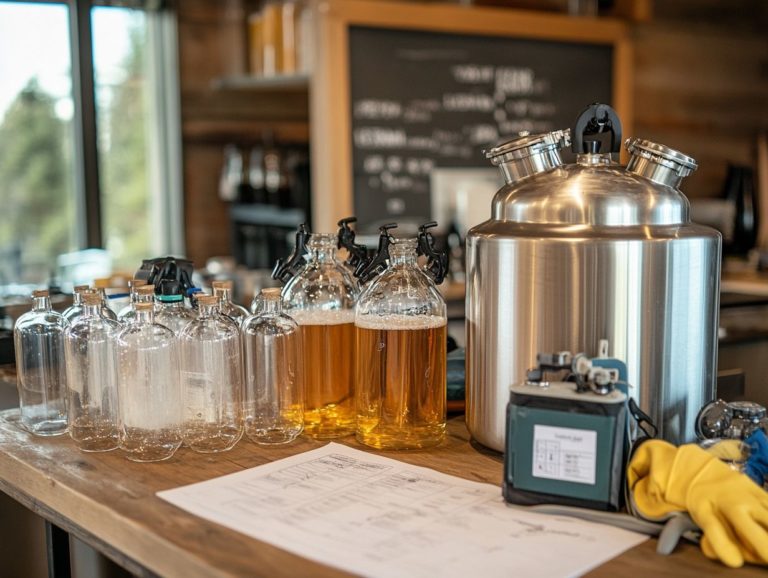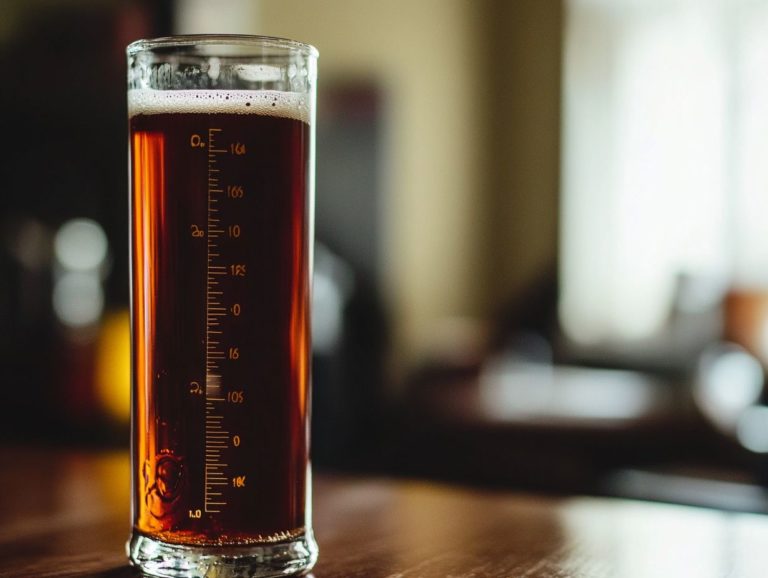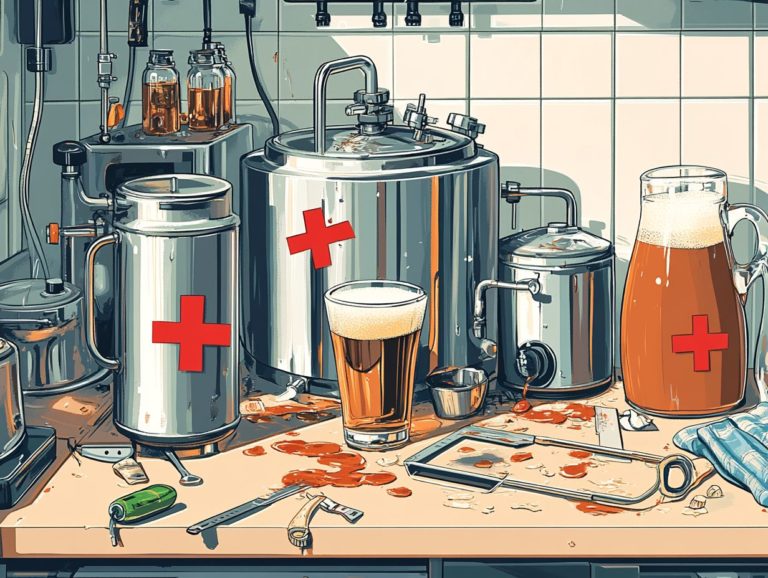The Essential Home Brewing Equipment for Beginners
Embarking on the journey of home brewing is an exhilarating and rewarding adventure. Understanding the essential brewing equipment required for a successful start is paramount for any aspiring beer brewer.
This guide outlines the must-have brewing essentials for every beginner, ranging from fermentation vessels to sanitizers. It ensures you establish a solid foundation for crafting your favorite beverages. This guide also covers additional equipment like a wort chiller, kegging system, and mash tun that can elevate your brewing experience. It offers insights on selecting the right gear tailored to your needs, whether you’re using a starter home brew kit or an advanced setup.
Get ready to unleash your inner brewmaster and dive into the exciting world of home brewing!
Contents
- What are the Essential Home Brewing Equipment for Beginners?
- 2. Airlock and Stopper
- 3. Hydrometer
- 4. Thermometer
- 5. Siphon and Tubing
- Tips for Choosing Home Brewing Equipment
- 3. Read Reviews and Do Research
- 4. Consider the Brewing Batch Size and Space You Have Available
- 5. Look for Quality and Durability
- Frequently Asked Questions
- What is the essential home brewing equipment for beginners?
- Do I need any specialized equipment for home brewing?
- How does a brewing kettle differ from a regular cooking pot?
- What is the purpose of an airlock in home brewing?
- Why do I need a hydrometer for home brewing?
- Can I reuse bottles for home brewing?
Key Takeaways:
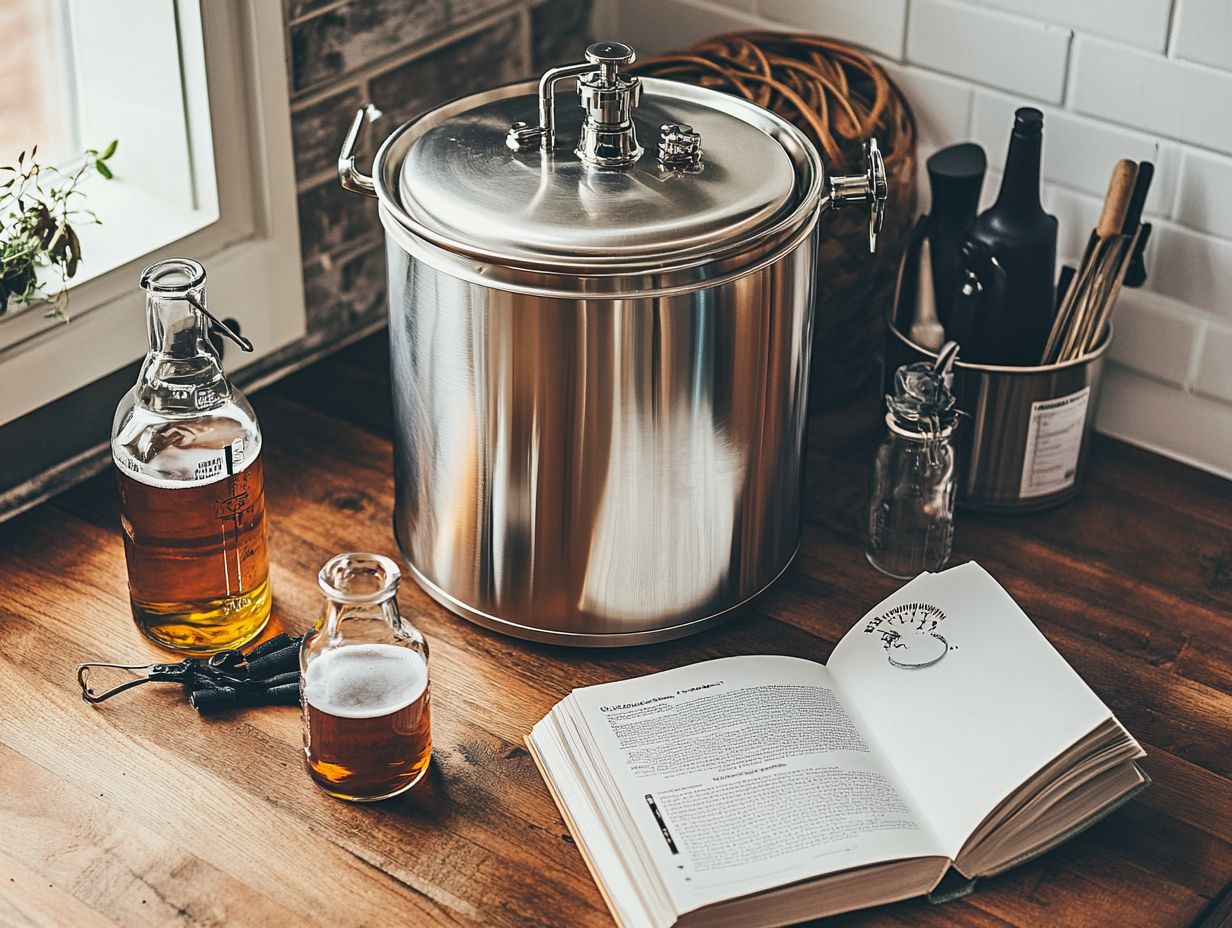
- Invest in a fermentation vessel, airlock and stopper, hydrometer, thermometer, siphon and tubing, bottles and bottle capper, and sanitizer for essential home brewing equipment.
- Consider investing in a wort chiller, mash tun, kegging system, brew kettle, or grain mill for advanced home brewing.
- When choosing home brewing equipment, consider your budget and brewing goals, read reviews, conduct research, and evaluate the space you have available for the equipment.
What are the Essential Home Brewing Equipment for Beginners?
As you embark on the thrilling journey of home brewing, it’s crucial to arm yourself with the essential equipment that will support both your novice and experienced brewing endeavors. Consider investing in a comprehensive home brew kit or even a beer brewing kit to get started.
Key items like a fermentation vessel, airlock, hydrometer, and thermometer will form the backbone of your brewing setup, ensuring that your beer-making process unfolds seamlessly and efficiently. Don’t forget to include a reliable bottle capper and high-quality beer bottles in your list of essential brewing supplies.
By understanding the functionality and significance of each piece of equipment, you will enhance your brewing experience. This knowledge allows you to concentrate on perfecting your beer recipes while mastering the fermentation process and achieving the desired alcohol content in your brews. This hands-on experience is invaluable for any brewing enthusiast looking to refine their brewing techniques.
1. Fermentation Vessel
A fermentation vessel, whether it s a 6-Gallon Primary Fermenter or a 5-Gallon Plastic Carboy, plays a pivotal role in your home brewing journey. These vessels, available from suppliers like Northern Brewer and BeerGrains, are essential for every homebrew setup. They create the perfect controlled environment for yeast to work its magic, converting sugars into alcohol during fermentation.
You ll find that different fermentation vessels come in various capacities and materials, significantly influencing your brewing results. For example, the 6-Gallon Primary Fermenter is perfect for larger batches. In contrast, the more compact 5-Gallon Plastic Carboy provides the versatility you need for those experimental brews.
The material of each vessel be it glass, plastic, or stainless steel can impact temperature regulation and oxygen exposure, both of which are crucial for successful fermentation. By carefully selecting the right vessel based on your brewing scale and the finish you desire, you can ensure optimal temperature control during fermentation. This enhances the flavor profile and achieves greater consistency.
This thoughtful selection ultimately contributes to your success in crafting exceptional beverages.
2. Airlock and Stopper
An airlock and stopper are important parts in your fermentation journey, expertly allowing carbon dioxide to escape while keeping contaminants at bay from your fermentation vessel.
These components are essential for maintaining a clean environment. This is crucial for achieving successful homebrews. As fermentation unfolds, yeast produces carbon dioxide that needs a safe exit; otherwise, you risk pressure buildup, which can lead to messy overflow or even vessel breakage. A top-quality stopper is equally vital, providing a secure seal that minimizes the chances of spoilage from airborne bacteria or wild yeast.
Homebrew clubs emphasize the importance of these tools, generously sharing tips on airlock usage to help you savor the best brewing experiences while protecting your cherished creations from unwanted intruders.
3. Hydrometer
A hydrometer is an essential tool in your brewing arsenal, allowing you to measure the density of your brew. This measurement helps you determine both the original gravity and final gravity, enabling you to calculate the alcohol content of your home brew. Consider studying brewing books like “The Complete Joy of Home Brewing” by Charlie Papazian to fully understand how to use a hydrometer effectively.
When you master the use of a hydrometer, you’ll gain invaluable insights into the fermentation process. To achieve precise readings, start by filling a test jar with wort and ensuring it s at the optimal temperature, as temperature fluctuations can impact density and affect your readings.
Begin by measuring the original gravity before fermentation; this establishes a baseline for the potential alcohol content. Once fermentation is complete, the final gravity reading will reveal how much sugar has transformed into alcohol.
Tracking these measurements over time is vital for perfecting your recipes and understanding yeast performance. This practice is vital for any brewing enthusiast who wants to take their craft to the next level!
4. Thermometer
A thermometer is critical for temperature control in your brewing setup, allowing you to monitor fermentation temperatures effectively. This ensures optimal yeast activity and helps prevent off-flavors in your beer. Proper fermentation temperature control is a cornerstone of successful home brewing.
You can choose from various types of thermometers, including digital and dial varieties. Digital thermometers are often favored for their quick and precise readings, making them ideal if you appreciate instant feedback. In contrast, dial thermometers, while sometimes delivering readings at a more leisurely pace, offer impressive durability and can be easily read from a distance, providing a straightforward visual reference during your brewing process.
No matter which type you choose, maintaining accurate temperature control is crucial for creating the ideal environment for yeast to flourish, ultimately enhancing the flavor profile of your brew. Keeping an eye on temperatures ensures fermentation stays on track don t risk ruining your brew!
5. Siphon and Tubing
A siphon and tubing are important tools for transferring your beer from one vessel to another, particularly during the bottling phase. These tools are crucial for maintaining the clarity and quality of your brew during the brewing process.
Understanding the siphoning process is vital for you as a brewing enthusiast, as it preserves the integrity of the flavors meticulously developed during fermentation. By employing a siphon, you can expertly separate the finished beer from sediment and other unwanted particles, facilitating a clean transfer into bottles or kegs.
There are various types of siphons available, including manual and auto-siphons, each tailored to different brewing styles. The choice of tubing materials, such as food-grade silicone or vinyl, can significantly enhance your brewing experience.
For those using home brew kits, investing in high-quality siphon equipment not only elevates the brewing process but also ensures that your final product shines with superior quality, free from any contamination!
6. Bottles and Bottle Capper
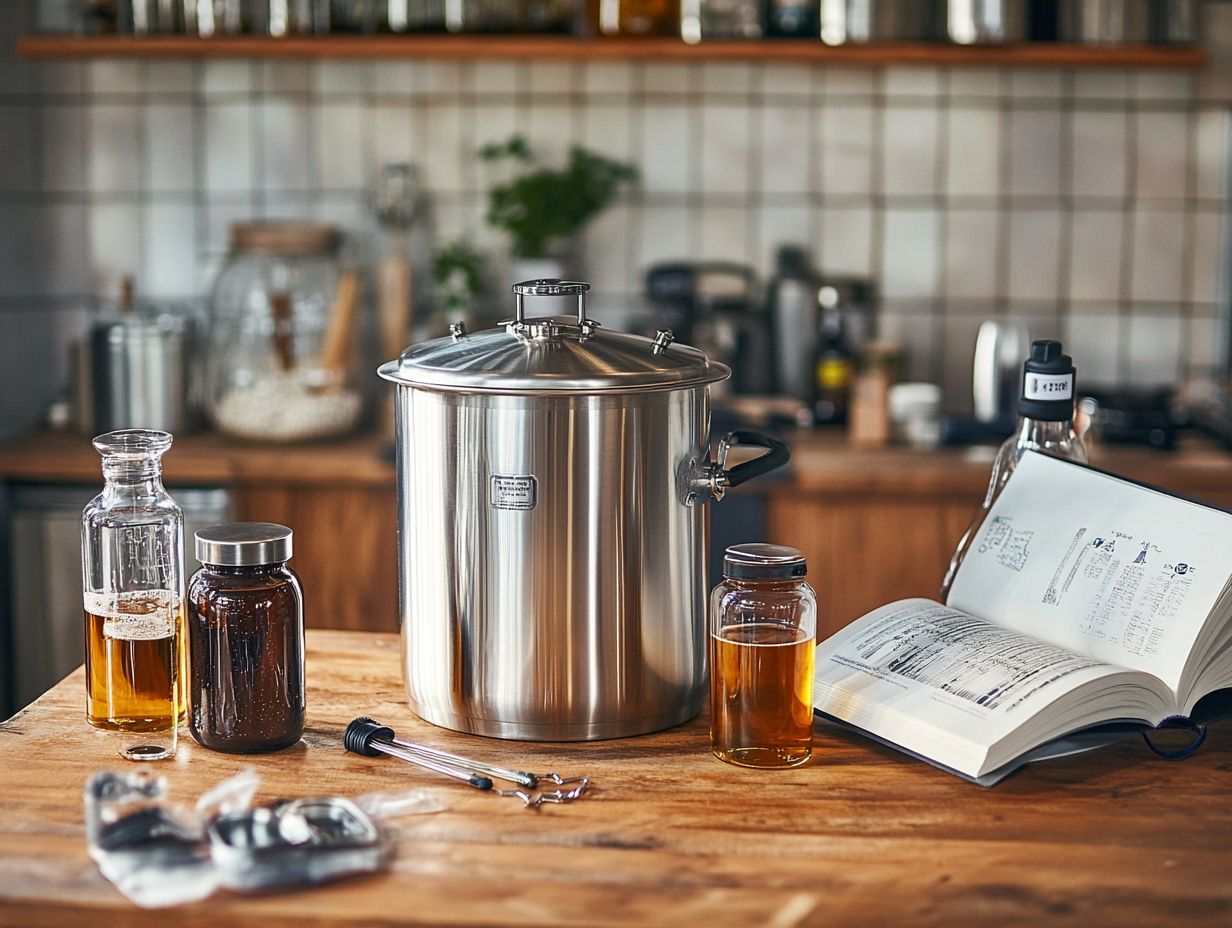
Choosing the right beer bottles and a reliable bottle capper is essential for preserving the quality of your beer and maintaining ideal carbonation levels after bottling. For a seamless bottling process, having a beer cleaning kit and a sanitizer solution is highly recommended. These elements are integral to any home brewing setup.
Regarding home brewing, glass bottles are often the go-to choice due to their airtight seal. However, plastic bottles can offer convenience and a reduced risk of breakage. Many home brewers also explore recycling options, like reusing commercial beer bottles or even soda bottles, provided they are thoroughly cleaned first.
Using a quality sanitizer solution is crucial to eliminate any lingering bacteria or impurities before filling your bottles. This ensures the integrity of your brew remains intact. A comprehensive beer cleaning kit simplifies the sanitation process for you, while a good bottle capper ensures that each bottle is sealed securely, preventing spills or loss of carbonation during storage.
7. Sanitizer
Sanitizer is a critical part of your brewing supplies. It ensures that every piece of equipment remains free from contaminants that could compromise the fermentation process and ultimately affect the quality of your final product. Cleaner sanitizer solutions maintain the hygiene of your brewing setup.
You ll find several types of sanitizers on the market, each offering varying levels of efficacy and methods of application. Don’t miss out consult brewing guides and literature to find the best method for your brewing needs. The most common options include iodine-based, chlorine-based, and quaternary ammonium compounds, often referred to as quats.
Iodine sanitizers are quite effective, but be mindful they can stain your equipment. On the other hand, chlorine-based sanitizers are potent against a wide range of pathogens, although they necessitate thorough rinsing afterward. Quaternary ammonium compounds are easy to use and don’t require rinsing, which makes them popular.
It s crucial to select the right sanitizer and adhere to the manufacturer s instructions regarding dilution and contact time. This ensures that all surfaces such as fermenters, bottling equipment, and tap lines are properly sanitized. A clean brewing setup elevates the flavor and quality of your brew, helping to prevent unwanted microbial growth, which can lead to off-flavors or spoilage.
What Other Home Brew Equipment Can You Invest In?
As you advance in your home brewing journey, consider acquiring additional brewing equipment such as a complete home brew kit. This thoughtful investment significantly elevates your brewing experience.
This opportunity opens the door to more sophisticated techniques, such as employing a wort chiller for rapid cooling or implementing a kegging system for convenient dispensing. Explore brewing literature to better understand these tools.
1. Wort Chiller
A wort chiller is a critical tool in your brewing arsenal. It is designed to cool your wort swiftly after boiling. This minimizes the risk of contamination and helps you maintain precise temperature control for the fermentation process.
You ll find several types of wort chillers at your disposal, including immersion chillers, counterflow chillers, and plate chillers, each with its unique advantages tailored to different brewing setups.
Immersion chillers are remarkably straightforward simply place a coiled copper or stainless steel tube directly into your heated wort while cold water circulates through the coils, cooling your liquid in no time.
Counterflow chillers send boiling wort through a tube that runs parallel to a water-filled line, allowing for rapid cooling. If you re working with limited brewing space, plate chillers present a compact solution, utilizing plates to ensure efficient heat exchange.
Each type of wort chiller caters to various brewing methods and volumes, enabling you to select the most suitable option for your specific needs.
2. Mash Tun
A mash tun is a vital piece of equipment in your brewing kit, especially if you’re exploring all-grain brewing. It s where you ll mix grains with water to extract essential fermentable sugars and determine the original gravity (the specific gravity of your wort before fermentation), setting the stage for the brewing process that follows.
This key component not only aids in mashing but also significantly shapes the flavor profile and body of your final brew. During the mashing process, the enzymes in the malted grains work to break down complex starches into simpler sugars crucial for fermentation. You can adjust the temperature and duration of mashing to create a variety of beers, whether you re targeting a light ale or a rich stout. This flexibility allows you to refine your recipes perfectly.
Moreover, the choice of grains and any additional ingredients you include at this stage can introduce unique flavors and aromas, showcasing your creativity and craftsmanship in brewing.
3. Kegging System
A kegging system provides the convenience of storing and dispensing your homebrew, making it an appealing choice for anyone looking to simplify their beer fermentation and serving. Remember to include a cleaner sanitizer and sanitizer solution as part of your regular maintenance routine.
Unlike traditional bottling, which necessitates filling and capping each individual beer, a kegging setup streamlines managing larger quantities with impressive efficiency. A typical kegging system consists of essential components like the keg itself, a CO2 tank for pressurization, and a regulator for controlling the gas flow. You can still use a bottle capper and beer bottles for smaller batches.
Combining these elements with taps and lines creates a setup that ensures smoother pouring, enhances flavor stability, and maintains carbonation over time. As a homebrewer, you ll appreciate the reduced cleanup and minimized risk of oxidation that comes with kegging. Make the leap from bottling to kegging for a smoother brewing experience!
4. Brew Kettle
A brew kettle is a crucial piece of equipment in your brewing setup, specifically designed for boiling the wort. This exciting step lets you infuse your brew with hops and other ingredients, elevating your beer-making process to new heights.
Brew kettles come in various sizes, catering to everyone from novice homebrewers with compact 1-gallon options to seasoned artisans who prefer 10-gallon or even 20-gallon kettles for larger batches. Each size serves a distinct purpose: smaller kettles are perfect for experimenting with different styles and recipes, while larger kettles enable you to craft intricate brews all in one go.
Beyond size, brew kettles can be made from different materials, such as stainless steel, aluminum, or copper. Each material uniquely influences the brewing process, adding an extra layer of complexity to your creations. Choosing a high-quality brew kettle is crucial to the success of your beer brewing efforts, as it can significantly impact the flavor, clarity, and overall quality of your final product. For precise measurements, consider using a thermometer and hydrometer during the brewing process.
5. Grain Mill
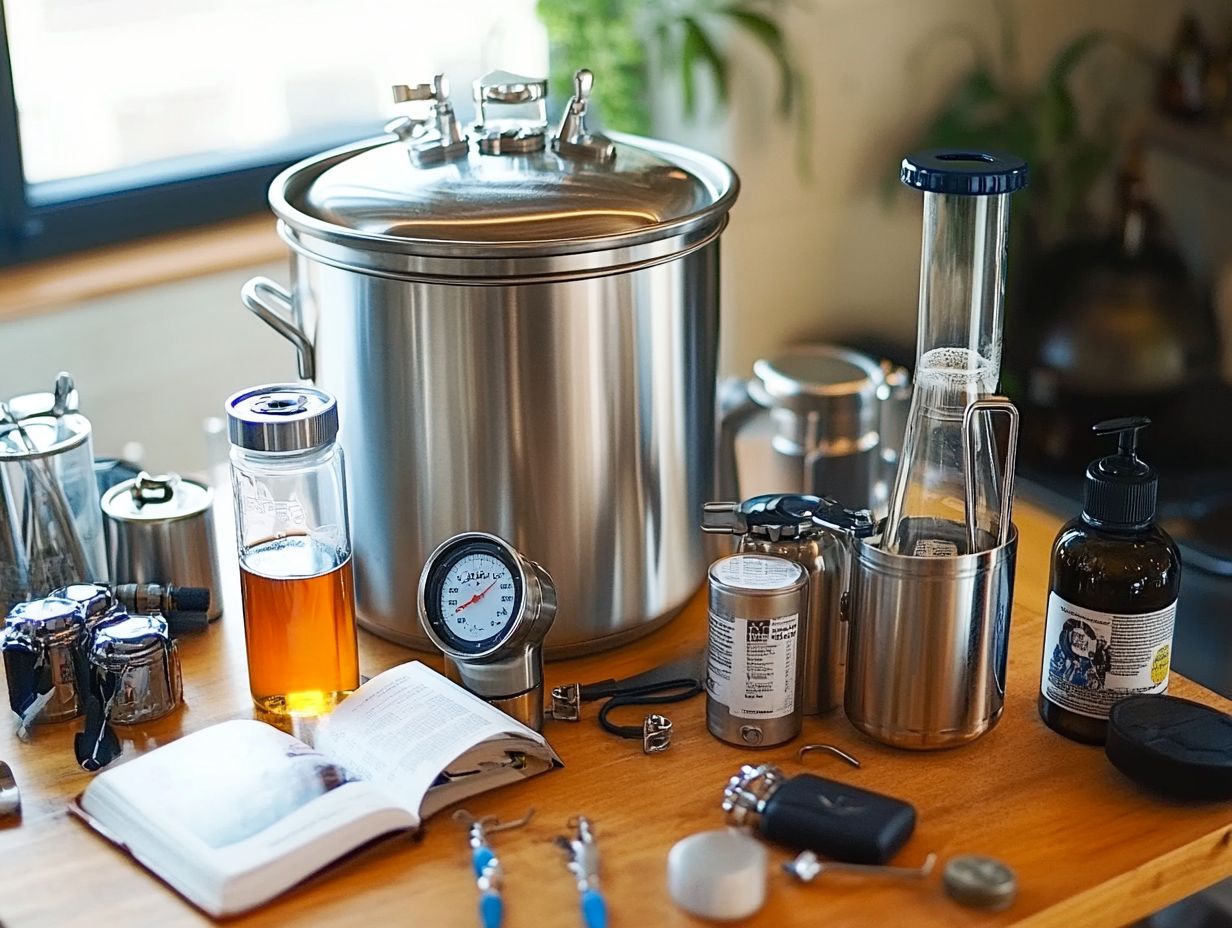
A grain mill stands as an essential tool in your brewing arsenal, enabling you to crush grains before mashing. This important step helps you get the most flavor from your grains and gives you greater control over your brewing techniques. Using a grain mill, along with a brew pot and measuring cup, prepares you for a streamlined brewing process.
By choosing the right mill, you can customize the grind size to fit various recipes, ensuring optimal sugar extraction and a well-rounded flavor profile. You ll primarily encounter two types of grain mills in the brewing world, often recommended by beer writers and brewing experts:
- The roller mill crushes grains effectively while preserving their husks.
- The hammer mill provides a finer grain crush, leading to different brewing results.
Using a grain mill not only elevates your brewing process but also opens the door to experimenting with different grain types and combinations, ultimately yielding unique beer flavors. This equipment deepens your understanding of the brewing craft, allowing you to make personalized adjustments and improvements to each batch.
Tips for Choosing Home Brewing Equipment
Don t wait! Start with a starter home brew kit to dive into the brewing experience. As you embark on your journey into the world of home brewing, selecting the right brewing equipment becomes essential for both your success and enjoyment of this craft.
You ll want to consider various factors, including your budget, brewing aspirations, and the quality and durability of each piece of equipment you choose.
1. Consider Your Budget
As you embark on your home brewing journey, staying within your budget is key to unlocking your brewing potential. The quality of brewing equipment can vary dramatically in price, and making wise investments will create a strong base for your brewing experience.
By carefully assessing your finances, you enable yourself to make informed choices that can significantly enhance both the brewing process and the final results of your creations. It’s wise to compile a comprehensive list of all the necessary supplies and equipment you’ll need; think fermenters, kettles, and sanitization tools. Additionally, consider the essential equipment for home brewing ciders to gain a clear picture of your initial costs.
Resources like brewing books by authors such as David Ackley or Marty Nachel can offer valuable guidance on budgeting and equipment selection.
Focusing on essential items that are critical for fermentation and brewing is especially important for beginners. Once you have the basics secured, you can consider optional upgrades. These could include advanced temperature control systems or specialized brewing kits. Additionally, integrating essential accessories for home brewing can truly elevate your craft, but they should be approached only after you’ve successfully mastered the fundamentals.
2. Think About Your Brewing Goals
Your brewing goals will profoundly shape the equipment you select, whether you aspire to craft specific beer recipes, explore innovative brewing techniques, or simply indulge in the joy of the hobby. Understanding the subtleties of various brewing styles is essential in guiding this decision-making process. Resources like The Complete Joy of Home Brewing by Ray Daniels can provide insights into different brewing styles and equipment needs.
For example, if you’re focused on creating complex Belgian ales, you might prioritize equipment that maximizes fermentation control, such as temperature regulators or specialized yeast starters. On the other hand, if you’re a novice homebrewer seeking a straightforward and enjoyable experience, essential safety equipment for home brewing like all-in-one brewing systems that simplify the entire process may be more appealing.
Institutions like the Siebel Institute of Technology and Oskar Blues Brew School offer courses that can help you understand these equipment options better.
By aligning your equipment choices with your brewing aspirations, you not only enhance your experience but also pave the way for more consistent and delightful outcomes, allowing you to cater to your personal tastes while venturing into new flavor territories.
3. Read Reviews and Do Research
Before you make any purchases, it s essential to read reviews and conduct thorough research on brewing supplies and equipment. This diligence ensures that you’re investing in quality products that will truly enhance your home brewing experience. Websites like Adventures in Homebrewing and Northern Brewer are excellent resources for product reviews and buying guides.
Engaging with trusted sources or participating in homebrew clubs can offer invaluable insights into what works best for specific brewing methods. You ll find that fellow enthusiasts often share their experiences with various brands, allowing you to weigh the pros and cons before making a decision. Consider joining a homebrew club to exchange tips on brewing essentials like the homebrew equipment from Steam Freak or BeerGrains.
When you evaluate products like fermenters, kettles, or specialty ingredients, it s wise to seek credible feedback that emphasizes durability, ease of use, and overall satisfaction. Join the vibrant brewing community to unlock amazing tips and tricks! By tapping into the collective wisdom of the brewing community, you can make informed choices that significantly elevate your craft, ensuring that every batch becomes a delightful journey of discovery. Always measure your final gravity the specific measurement of your beer’s sweetness before fermentation is complete to ensure the quality of your brew, a practice recommended in brewing books like those by Ray Daniels.
4. Consider the Brewing Batch Size and Space You Have Available
Considering the space available in your home for brewing is paramount, as it dictates the size and complexity of the setup you can establish. This ultimately influences your entire brewing process, from the initial stages to the final bottling.
A dedicated brewing area enhances your workflow efficiency and ensures precision at every stage of your craft. As you optimize this space, prioritize ergonomics and accessibility. Key elements include sturdy countertops for your equipment, convenient access to water sources, and proper ventilation these are essential for a successful brewing experience.
Having a thermometer and a hydrometer within reach can help you monitor key metrics like temperature control and original gravity. In this thoughtfully arranged environment, you’ll find it easy to organize your tools and ingredients like your brewing kettle, fermenter, and other essential tools every home brewer needs, allowing for a seamless transition between brewing stages.
A well-structured brewing area minimizes distractions and mess, transforming your hobby into a more enjoyable and productive pursuit.
5. Look for Quality and Durability
Investing in high-quality, durable brewing equipment like a brew kettle, immersion chiller, or a home brew kit is crucial for your brewing success and the longevity of your supplies, ensuring they perform effectively over time.
Selecting equipment that showcases exceptional craftsmanship can significantly elevate your overall brewing experience. As you choose your items, consider factors such as material quality, weight, and the manufacturer s reputation.
Durable materials like stainless steel or heavy-duty glass offer superior heat retention and corrosion resistance, resulting in more consistent brewing outcomes. Opting for reputable brands often means you ll receive outstanding customer service and support, giving you peace of mind as you embark on your brewing adventures. Brands like Northern Brewer or BeerGrains are known for their exceptional quality and customer support.
By making informed decisions about your equipment, you can enhance your current setup and lay the groundwork for future successes.
Frequently Asked Questions
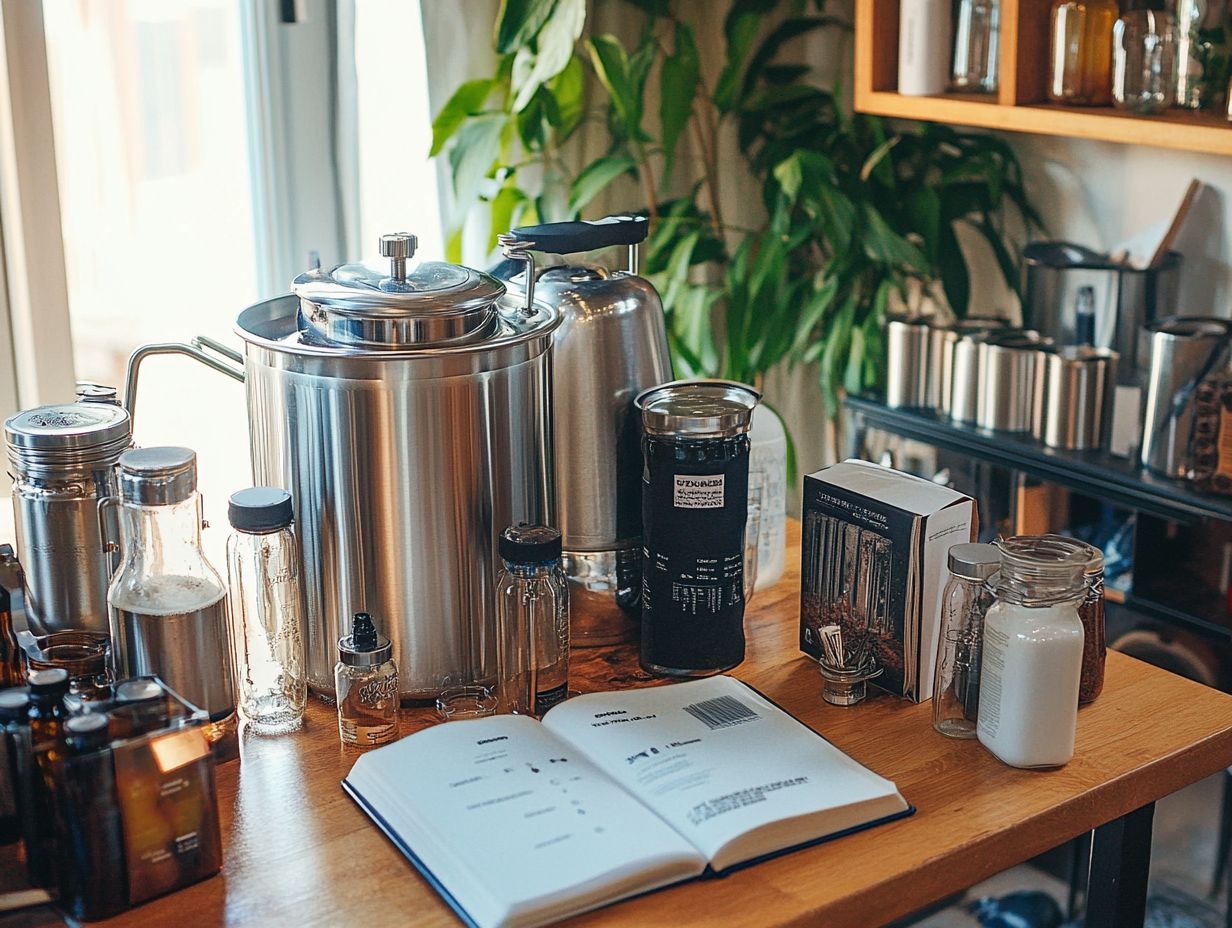
What is the essential home brewing equipment for beginners?
The essential home brewing equipment for beginners includes a brewing kettle, fermenter, airlock, hydrometer, thermometer, siphon, bottles, bottle capper, and a beer ingredient kit.
Do I need any specialized equipment for home brewing?
No, you do not need any specialized equipment for home brewing. Most of the equipment can be found in your kitchen or can be easily purchased at a brewing supply store, although a home brew kit can simplify the process.
How does a brewing kettle differ from a regular cooking pot?
A brewing kettle is specifically designed for brewing beer. It features a spigot for easy transfer of unfermented beer and a built-in thermometer for accurate temperature control.
What is the purpose of an airlock in home brewing?
An airlock allows carbon dioxide to escape during fermentation. It also prevents outside air or contaminants from entering the fermenter, ensuring your brew stays safe.
Why do I need a hydrometer for home brewing?
A hydrometer measures the specific gravity of your beer. This indicates the amount of fermentable sugars present, helping you determine the completion of fermentation and the alcohol content. With a hydrometer in hand, you re on your way to brewing your perfect beer!
Can I reuse bottles for home brewing?
Yes, you can reuse bottles as long as they are properly cleaned and sanitized. Using a reliable cleaner ensures they are free from contaminants, or you can choose to buy new beer bottles for brewing.

